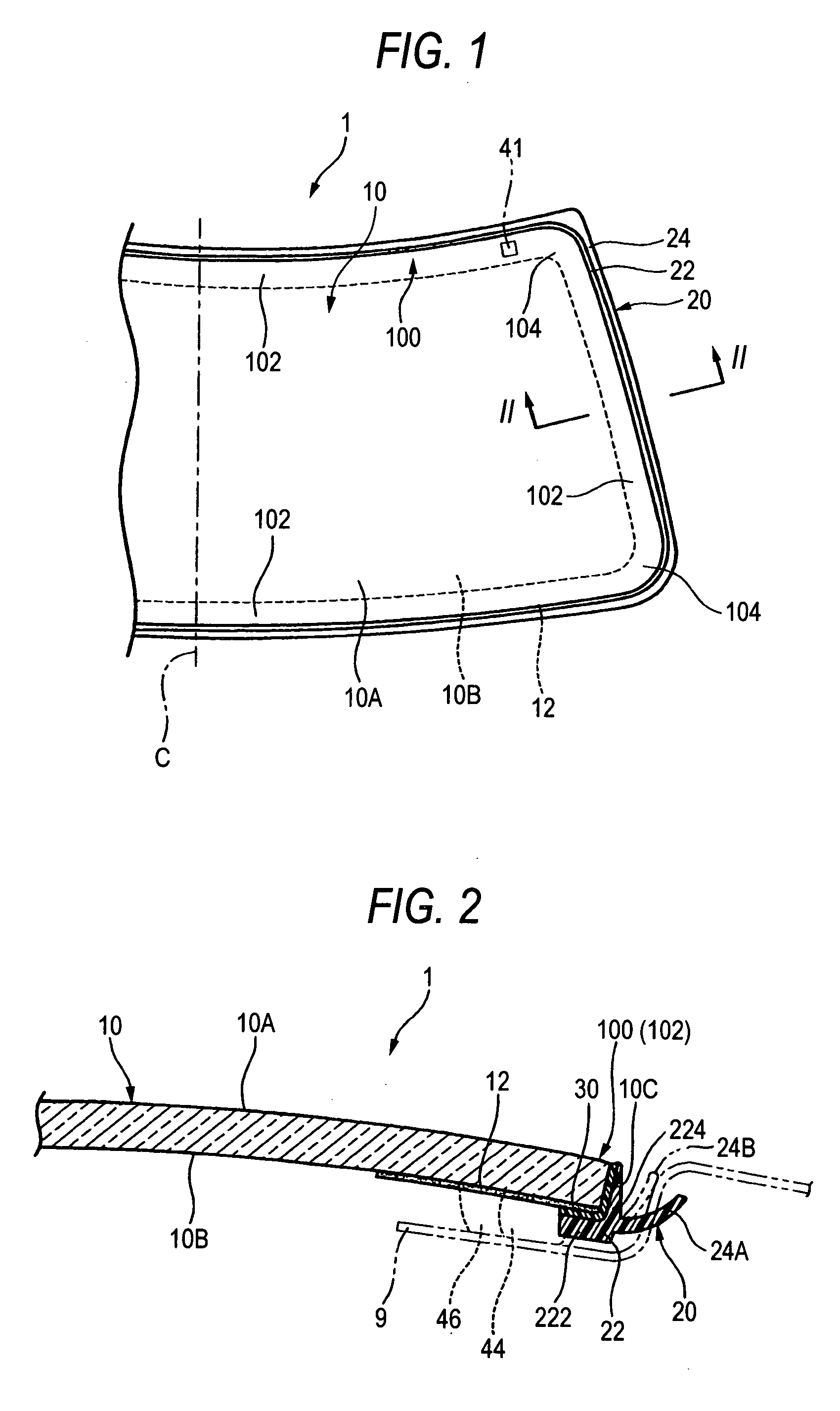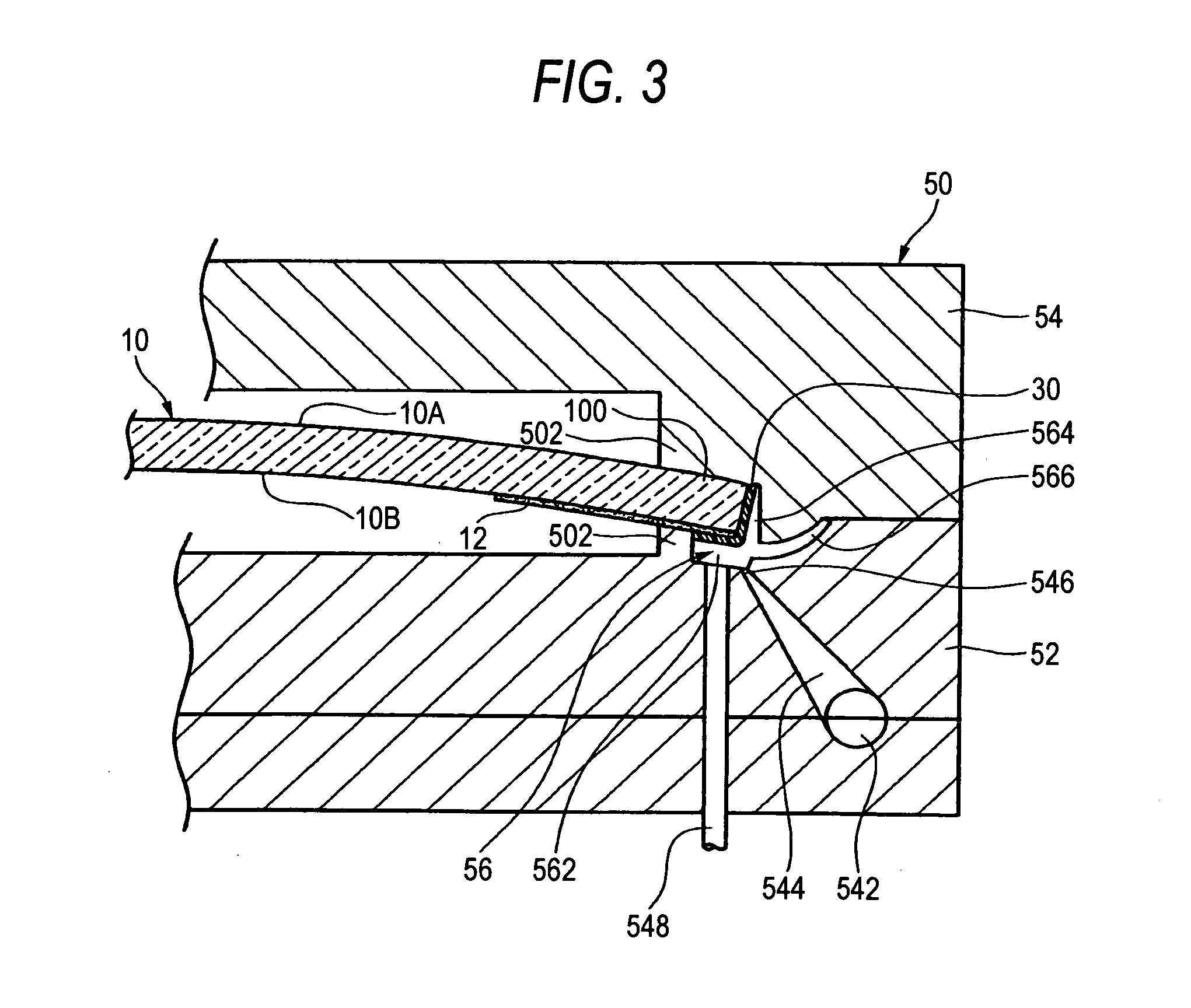Window assembly and method for manufacturing the same
a technology for windows and doors, applied in the field of windows, can solve the problems of difficult use of tpe for concealing members, general adhesion of tpe to inorganic glass, etc., and achieve the effect of preventing unexpected damage, high degree of freedom, and not giving excessive flow resistance to the forming material
- Summary
- Abstract
- Description
- Claims
- Application Information
AI Technical Summary
Benefits of technology
Problems solved by technology
Method used
Image
Examples
first embodiment
[0046] The invention will be described on the case where the invention is applied to a back window of a car.
[0047] As shown in FIG. 1, a window assembly 1 for a back window according to this embodiment has a transparent window pane 10 including a front surface and a rear surface, and a concealing member 20 provided along a peripheral edge portion (peripheral edge) 100 of the transparent window pane 10. The window assembly 1 is formed to be substantially symmetrical about a line C shown in FIG. 1. The outer circumferential shape of the window pane 10 is roughly rectangular in front view. The outer circumferential shape of the window pane 10 has four linear portions 102 comparatively nearly linear and corner portions 104 located between adjacent ones of the nearly linear portions 102. In this embodiment, the concealing member 20 is formed on the whole circumference of the window pane 10. That is, the concealing member 20 is formed continuously in an area covering the linear portions ...
second embodiment
[0066] In a second embodiment, a window assembly is manufactured with a configuration in which during injection molding of a concealing member, a part of an injected material is fluidized to make it possible to bond a fixture such as an attachment clip to the rear surface of a window pane. Members having the same functions as those of the members in the first embodiment are denoted by the same reference numerals correspondingly and description of these members will be omitted.
[0067] As shown in FIG. 4, in a window pane 10, adhesive layers 30 and 32 are formed in advance on the portion of the window pane rear surface 10B where a concealing member 20 will be formed and the portion of the window pane rear surface 10B where a fixture 42 will be fixedly attached, in the same manner as in the first embodiment. When an injection mold 50 is opened, the fixture 42 is set in a predetermined position in the mold 50 (core mold part 52) and the window pane 10 is then set. When the mold 50 is cl...
third embodiment
[0069] In a third embodiment, the invention is applied to a vehicle quarter window (such as a rear quarter glass window of a passenger car or a van, or a glass window in a luggage compartment side surface of a station wagon) by way of example. As shown in FIGS. 5 and 6, in a window assembly 3 according to the embodiment, a base portion 22 of a concealing member 20 is formed continuously in an area ranging from a rear surface 10B of a peripheral edge portion 100 of a window pane 10 to a front surface 10A thereof via an end surface 10C thereof. The base portion 22 is bonded to the window pane 10 through an adhesive layer 30 provided in advance (before the concealing member 20 is formed), in the same manner as in the aforementioned embodiments. The window assembly 3 thus configured is attached so that a thin and elastic projection portion 24 of the concealing member 20 is brought into elastic contact with a car body panel constituting a window opening edge 9 of a body to be attached (a...
PUM
| Property | Measurement | Unit |
|---|---|---|
| temperature | aaaaa | aaaaa |
| temperature | aaaaa | aaaaa |
| injection pressure | aaaaa | aaaaa |
Abstract
Description
Claims
Application Information
 Login to View More
Login to View More - R&D
- Intellectual Property
- Life Sciences
- Materials
- Tech Scout
- Unparalleled Data Quality
- Higher Quality Content
- 60% Fewer Hallucinations
Browse by: Latest US Patents, China's latest patents, Technical Efficacy Thesaurus, Application Domain, Technology Topic, Popular Technical Reports.
© 2025 PatSnap. All rights reserved.Legal|Privacy policy|Modern Slavery Act Transparency Statement|Sitemap|About US| Contact US: help@patsnap.com



